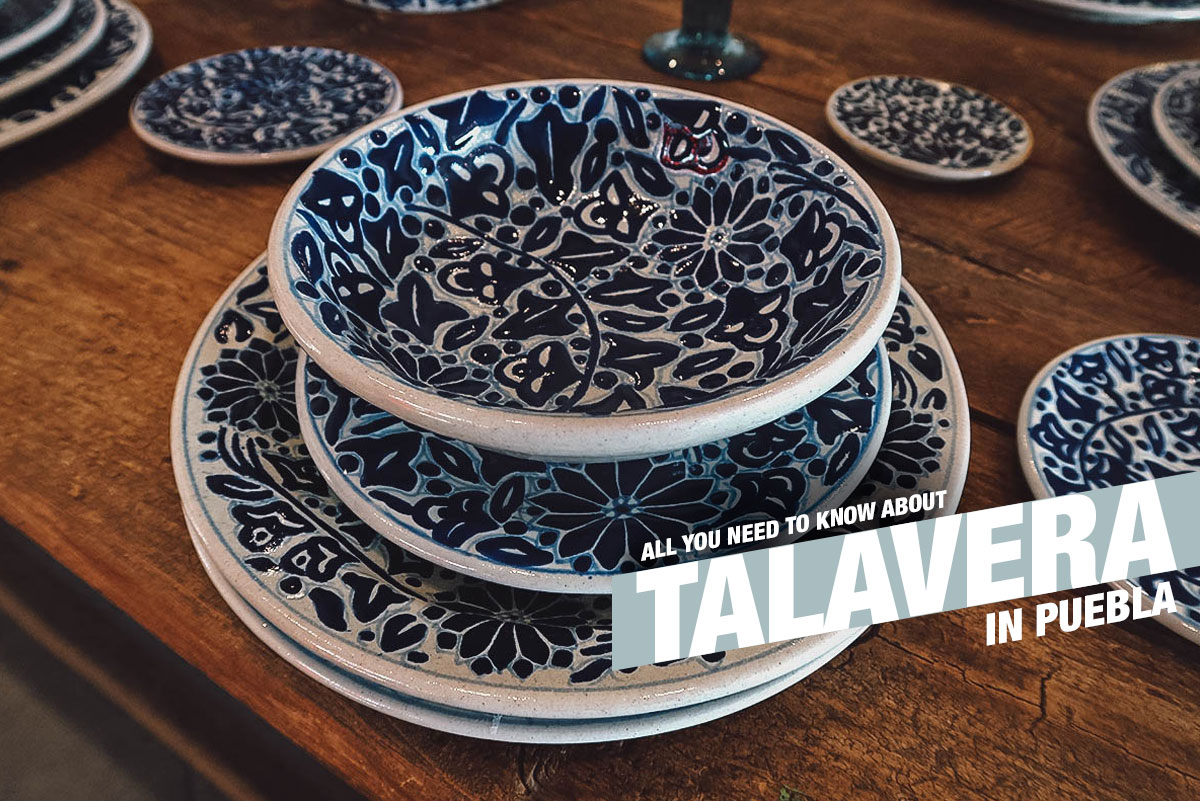There are many different types of souvenirs you can buy in Puebla, but only a select few are truly emblematic of the city and state. Mole Poblano is one, Talavera Poblana pottery is another. Talavera Poblana refers to a type of majolica pottery (tin-enameled earthenware) from Puebla, Mexico.
Talavera ceramics come in the form of utilitarian items like plates and bowls but it’s also made into decorative tiles which have been used to adorn the many churches and buildings in the Historic Center of Puebla. Known as azulejos, these decorative Talavera tiles are a defining characteristic of Puebla’s colonial architecture and what sets it apart from the rest of Mexico.
Spend a day in Puebla and it becomes apparent how important Talavera ceramics are to this city’s identity and heritage. In this article, we’ll tell you all about Talavera pottery and why you should bring home a piece or two on your next visit to Puebla.
VISIT PUEBLA QUICK LINKS
TOURS
If you’re interested in joining a tour in Puebla, then we’ve compiled links to popular tours and activities here. Click on the link for a guide to some of the best Puebla Tours.
- Guided Tours: Puebla Sightseeing and Food Tours
- Day Trips: Day Trips to Puebla from Mexico City
- Cooking Classes: Puebla Cooking Classes
HOTELS
Top-rated hotels in the Historic Center, the best area to stay for people on their first trip to Puebla. Click on the link for more Puebla hotel recommendations.
- Luxury: Casona de los Sapos Hotel Boutique
- Midrange: Hotel Boutique Casareyna
- Budget: Hostal Casa De Arcos
OTHER SERVICES
- Mexico Tourist Card (FMM)
- Travel Insurance (with COVID cover)
- Mexico SIM Card / eSIM
- Car Rental
- Mexico Bus Tickets
PUEBLA TRAVEL GUIDE
Check out our in-depth Puebla City travel guide for more helpful tips.
Save This on Pinterest!
No time to read this guide on Talavera pottery in Puebla? Click on the save button and pin it for later!
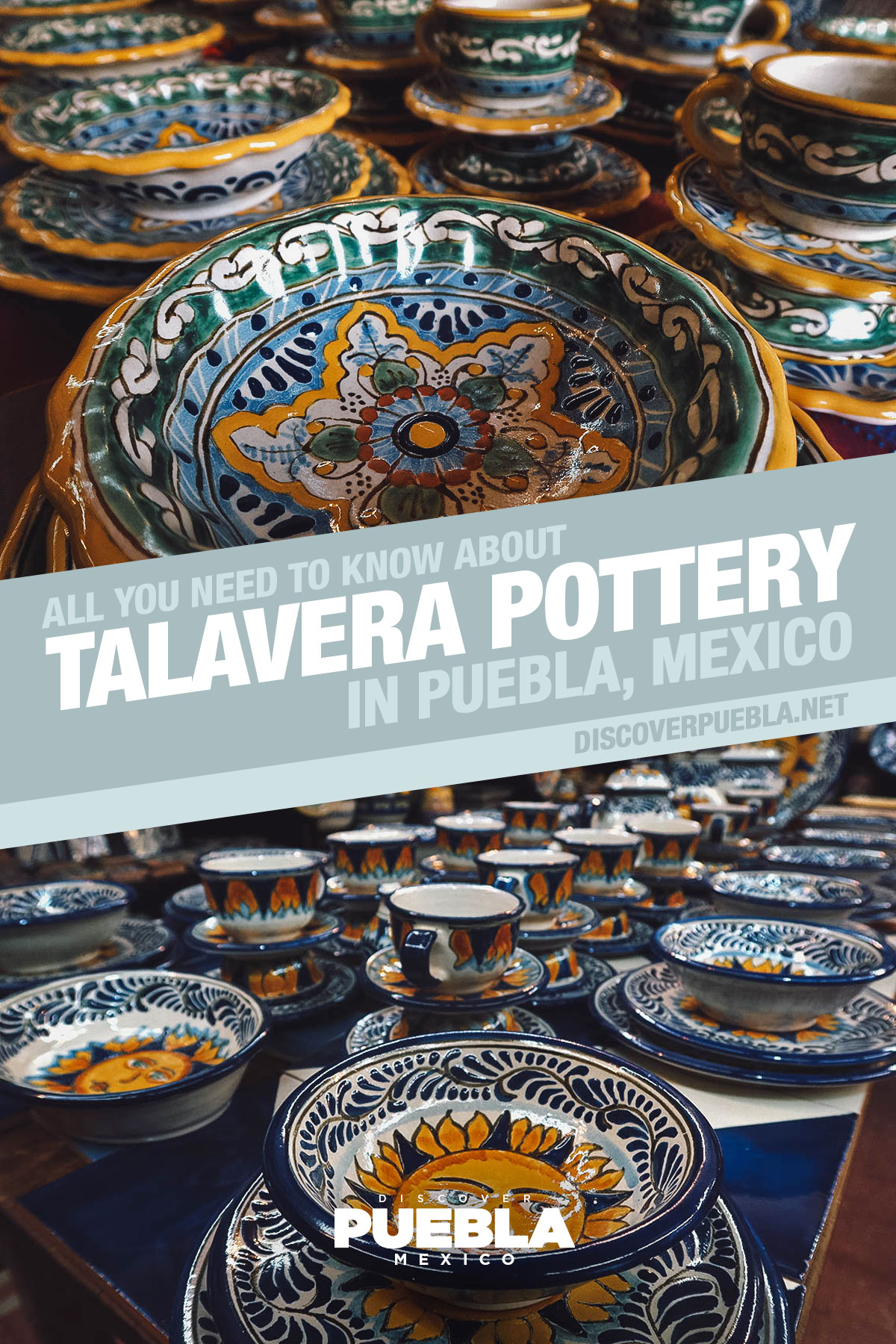
WHAT IS TALAVERA POBLANA?
Talavera Poblana is a Mexican pottery tradition from Puebla, Mexico. Originally from Talavera de la Reina in Spain, it was brought to Mexico during the 16th century and refers to a type of majolica pottery or tin-enameled earthenware.
Thanks to the region’s abundance of high-quality natural clay, Mexican Talavera is associated with the cities of Puebla, Cholula, Atlixco, and Tecali in Puebla state, as well as with the town of San Pablo del Monte in Tlaxcala.
Talavera is used mainly to create household items like tableware, pots, and decorative figurines, but it’s also used to make azulejo tiles. Buildings and churches adorned with decorative azulejos are a common sight in the city of Puebla.
Talavera ceramics produced in Mexico are referred to as Talavera Poblana to distinguish them from the Talavera produced in Spain.
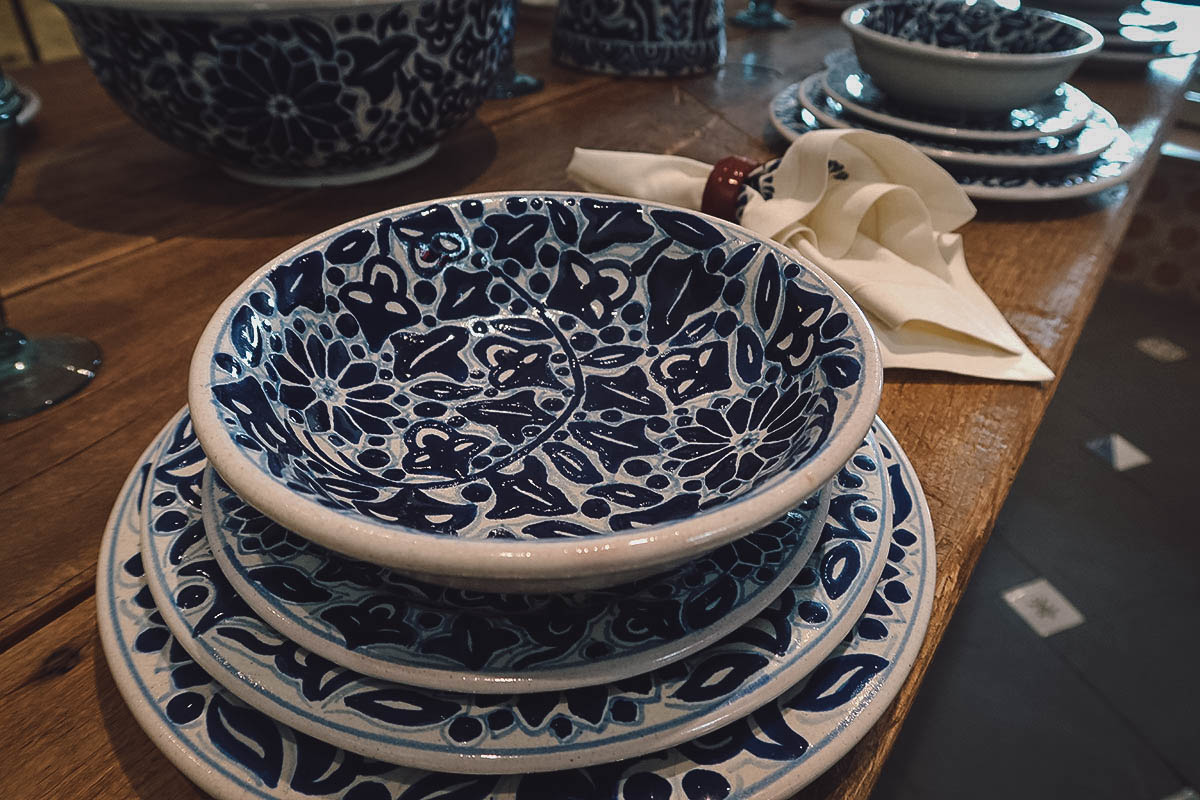
Talavera de la Reina
Talavera de la Reina is a Spanish city in the autonomous community of Castille-La Mancha. Nicknamed “La Ciudad de la Ceramica” (The City of Pottery), it’s internationally renowned for its pottery tradition which was awarded International Cultural Heritage status by UNESCO in 2019.
The Mexican Talavera tradition was named after Talavera de la Reina.
HISTORY OF TALAVERA POTTERY IN PUEBLA
Although Talavera-style pottery was brought to Puebla from Spain, pottery has existed in Mexico since pre-colonial times. Pre-Hispanic cultures have practiced their own pottery-making tradition for centuries, albeit without the use of a potter’s wheel or glazing.
There are several theories as to how the Talavera tradition was brought to Mexico. The most popular asserts that Spanish monks from the Santo Domingo monastery in Puebla sent for artisans from Talavera de la Reina to teach the locals how to make pottery similar to the ones produced in Spain. Many monasteries were being built in Puebla at the time and the monks wanted to adorn them with Talavera tiles.
The demand for tiles to decorate the monasteries and churches in Puebla City, coupled with the availability of high-quality clay in the region, led to the rise of Puebla’s ceramic industry. The industry flourished and by 1580, Puebla became the center of Talavera production in Mexico.
From the late 16th century till the mid-17th century, Puebla saw a boom in its ceramic industry, prompting the colonial government to regulate it with guilds and standards. The period between 1650 and 1750 is recognized as the Golden Age of Talavera, with Puebla becoming the most important earthenware production center in the New World.
HOW IS TALAVERA MADE?
Talavera production is an elaborate process that has remained largely unchanged since colonial times.
It starts by mixing two types of natural clay – a dark clay from Amozoc and a lighter, slightly rose-colored clay from Tecali. The clay mixture is then shaped by hand on a potter’s wheel before being left to dry for several days.
After drying, the piece is fired at 1,560 °F (850 °C). It’s then tested for cracks before being glazed with a mixture containing tin and lead to give it a milky white appearance. This will serve as the background on which the design will be hand-painted.
In the early days, only cobalt blue was used to decorate the pottery. At the time, cobalt blue was the most expensive pigment to produce. This ensured their quality and made the Talavera pieces even more prestigious and expensive. When customers saw cobalt blue on a Talavera piece, they knew it was of the highest quality.
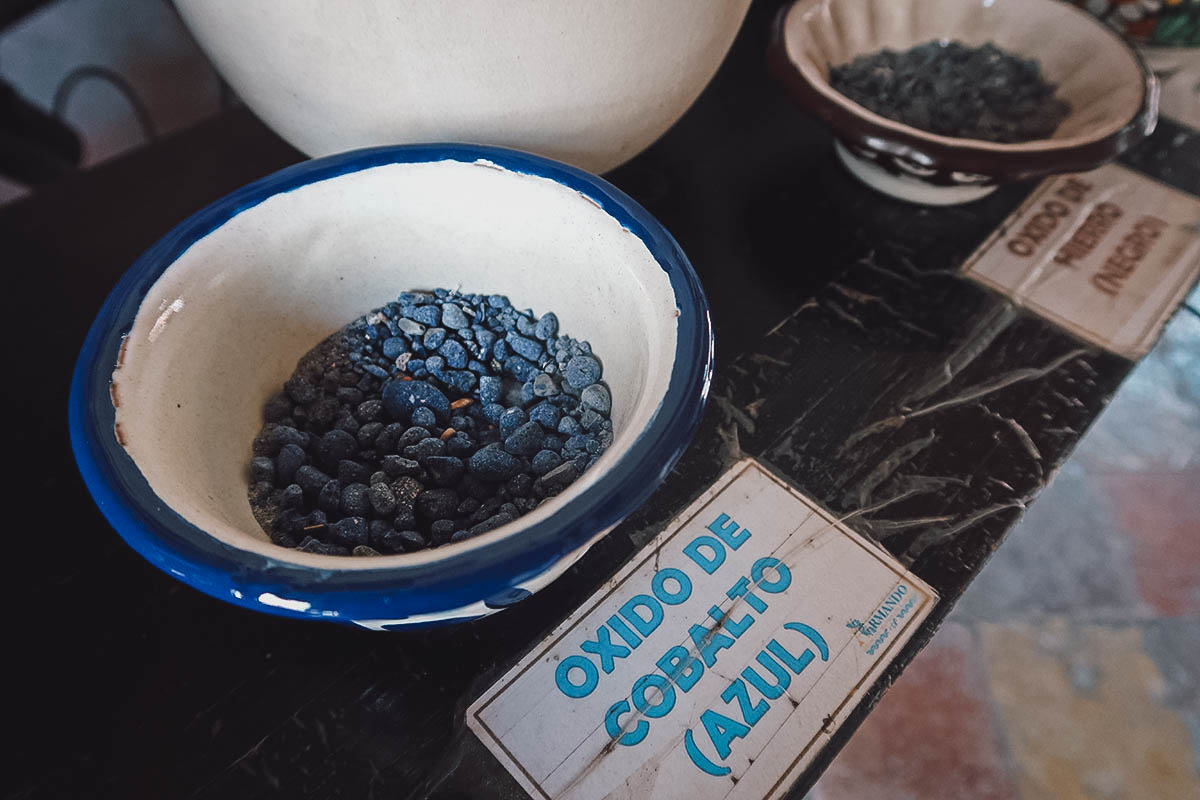
Over time, five other colors were introduced – yellow, orange, green, mauve, and black. To this day, only those six colors made from all-natural paints can be used on authentic Talavera.
After the piece has been painted, it’s fired for a second time to harden the glaze. The entire Talavera-making process takes about three to six months to complete. It’s a tricky process because the piece can break at any time, which is partly what makes Talavera so expensive – around three times more than other types of Mexican pottery.
TALAVERA POBLANA CERTIFICATION
How can you tell if the pottery is authentic Talavera? Everyone looking to buy authentic Talavera needs to know this.
Authentic Talavera has to be certified in order to officially carry the “Talavera” name. The Denominación de Origin de la Talavera was established in 1997 specifically for this purpose. The city of production, the clay that was used, and the manufacturing process are all taken into consideration when certifying a piece of Talavera.
Only pieces that were produced in certain areas by specific workshops are allowed to be called “Talavera”. Certification is issued by the Consejo Regulador de Talavera (Mexican Talavera Regulatory Council), with all certified pieces being sold with a special hologram to guarantee their authenticity.
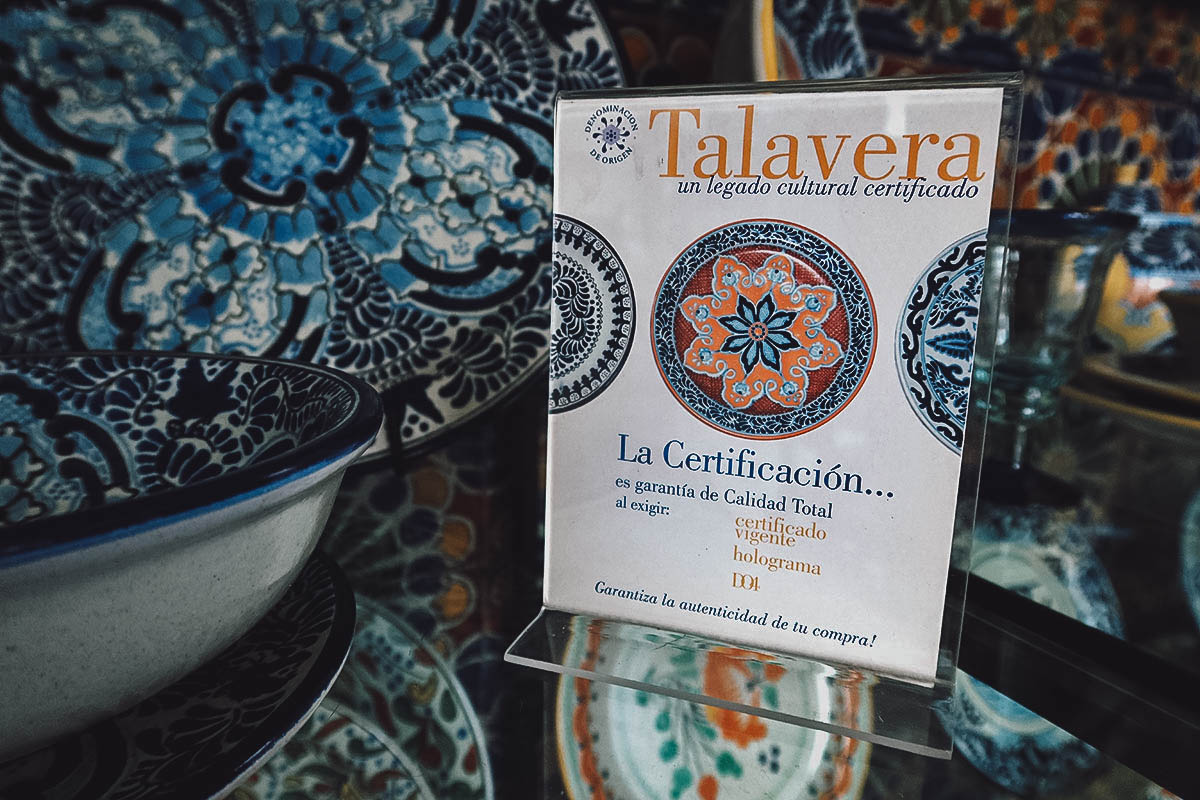
Mexican Talavera Regulatory Council
The Consejo Regulador de Talavera was established in 1998 to regulate the production of Talavera in Mexico.
As of this writing, only nine workshops have been certified to produce authentic talavera: Uriarte Talavera, Talavera La Reyna, Talavera Celia, Talavera de la Luz, Talavera Armando, Talavera Santa Catarina, Talavera de la Nueva España, Talavera de las Americas, and Talavera Virglio Perez.
Pictured below is the Consejo Regulador de Talavera certificate issued to Talavera Armando. This certifies that the pieces produced in this workshop are indeed authentic Talavera.
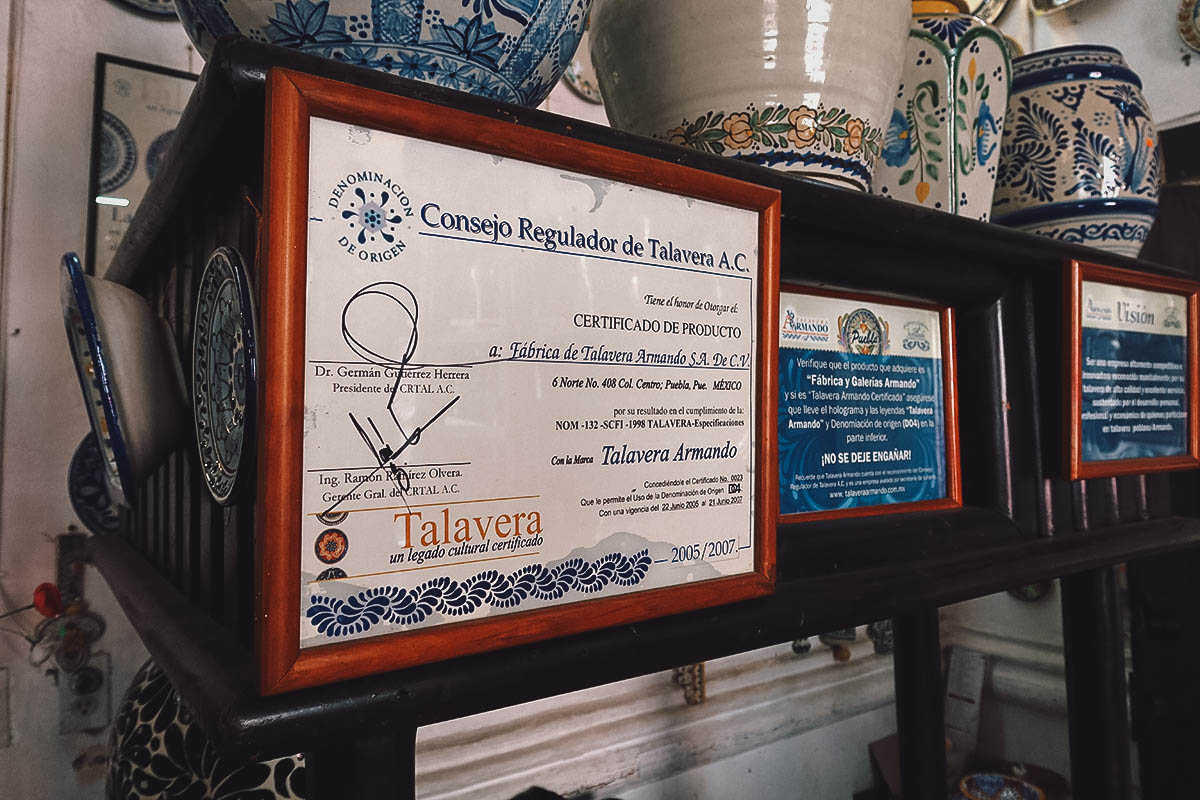
In order to maintain their certification, workshops must pass a twice-yearly inspection of their manufacturing process. Pieces are subject to sixteen laboratory tests conducted by internationally certified labs.
On top of that, since most Talavera pieces are meant to be used for food and drink, a test is done by the Faculty of Sciences of the University of Puebla to ensure that each piece contains safe levels of lead and cadmium.
RELATED ARTICLE: Discover Cantona Ruins, the Most Well-Preserved Archaeological Site in Mexico
WHERE TO BUY CERTIFIED TALAVERA POTTERY IN PUEBLA CITY
As described, only nine workshops are certified producers of authentic Talavera: Uriarte Talavera, Talavera La Reyna, Talavera Celia, Talavera de la Luz, Talavera Armando, Talavera Santa Catarina, Talavera de la Nueva España, Talavera de las Americas, and Talavera Virglio Perez.
Of those nine, I’ve visited these four so far.
4. Casa de Talavera Celia
Founded in 1992, Casa de Talavera Celia is home to both the workshop and the Museo de la Talavera, one of the many museums you can visit in Puebla. It’s located in a residential neighborhood near the Zona Histórica de los Fuertes, about a 10-minute Uber ride from Puebla City’s zocalo (main square).

On the second floor of the workshop is this small museum of Talavera pieces. I’m not sure if the pieces here are for sale but the ones on the first floor definitely are. Admission to the museum is free.
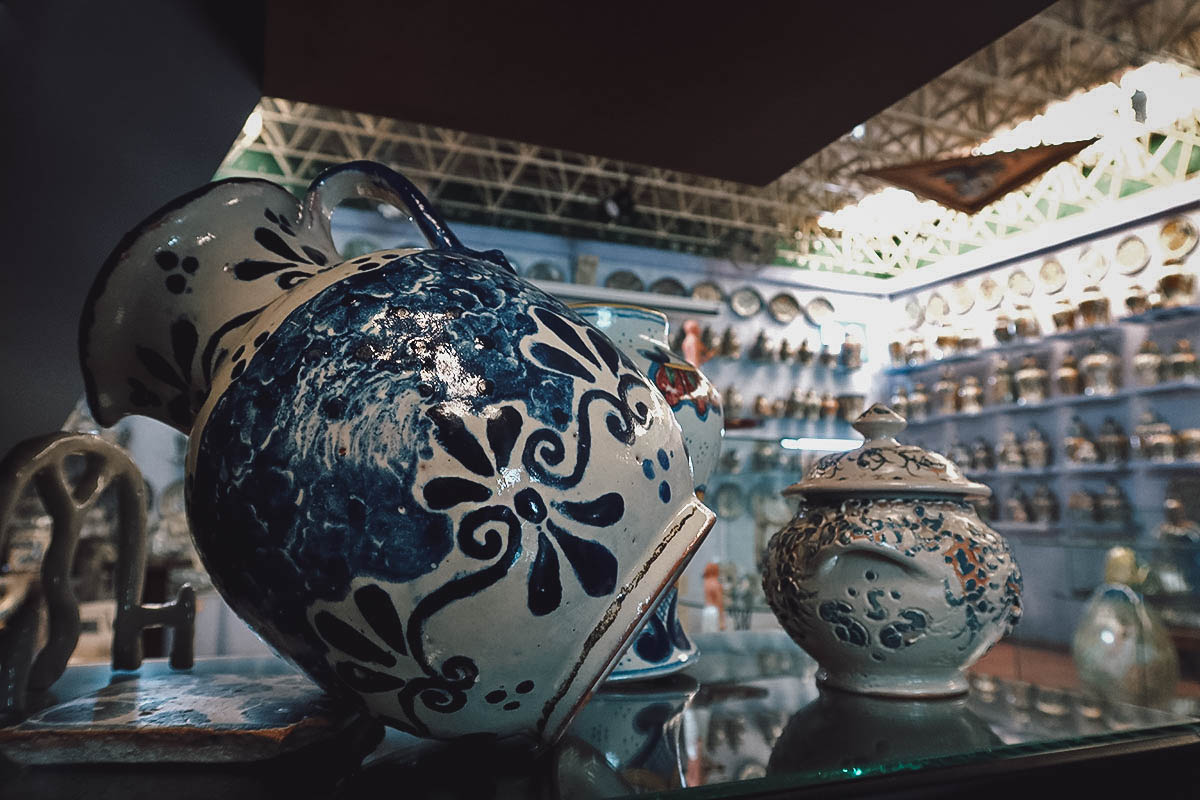
Casa de Talavera Celia offers guided tours where you can watch their artisans at work and learn about the Talavera-making process. You can contact them directly to make arrangements.
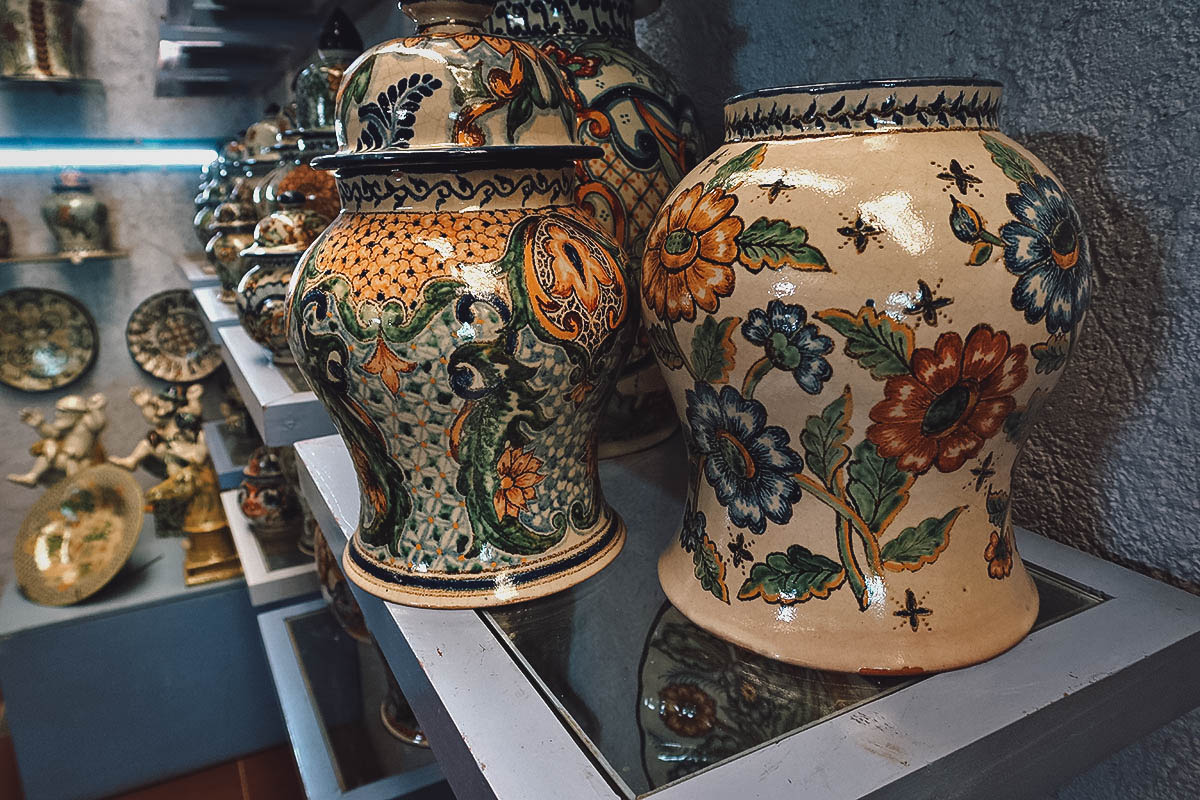
Casa de Talavera Celia
Address: C. Fresno 97 A, Arboledas de Guadalupe, 72260 Puebla, Puebla
Operating Hours: 9AM-5PM, Mon-Fri / 9AM-3PM, Sat (closed Sundays)
Website: talaveracelia.com
3. Fabrica de Talavera Armando
If you’d rather not stray too far from downtown Puebla, then you can go to Fabrica de Talavera Armando. It’s located about a 10-minute walk northeast of the zocalo.

Cobalt blue is a defining color of Talavera Poblana. In my opinion, all-blue Talavera pieces are the most beautiful.
Note the slightly raised finish of the paint. This is characteristic of Talavera pottery.
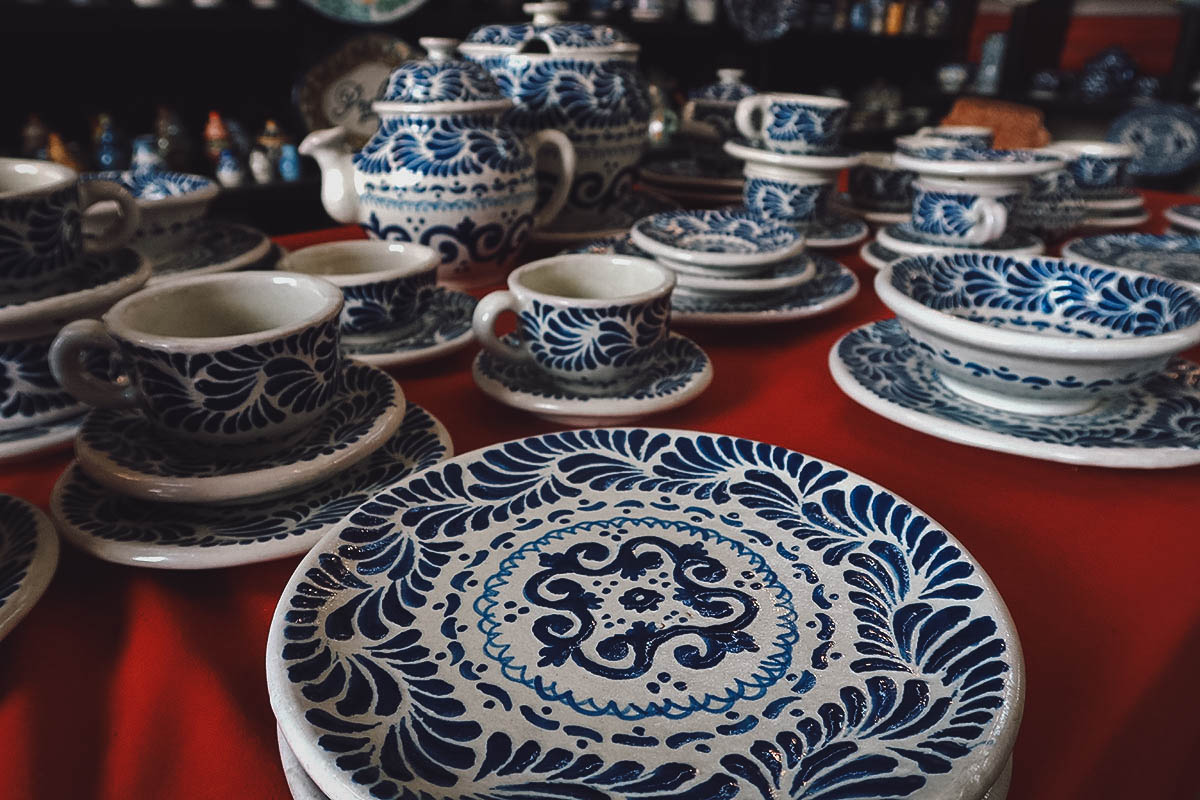
Fabrica de Talavera Armando is one of the youngest Talavera workshops in the city of Puebla. Based on what I’ve read, they’ve been producing fine pieces of Talavera pottery for about twenty years.

If you look under any piece, you’ll find the logo and/or name of the manufacturer, the initials of the artist, and the location of the manufacturer in Puebla. This information is required on all certified pieces of Talavera.
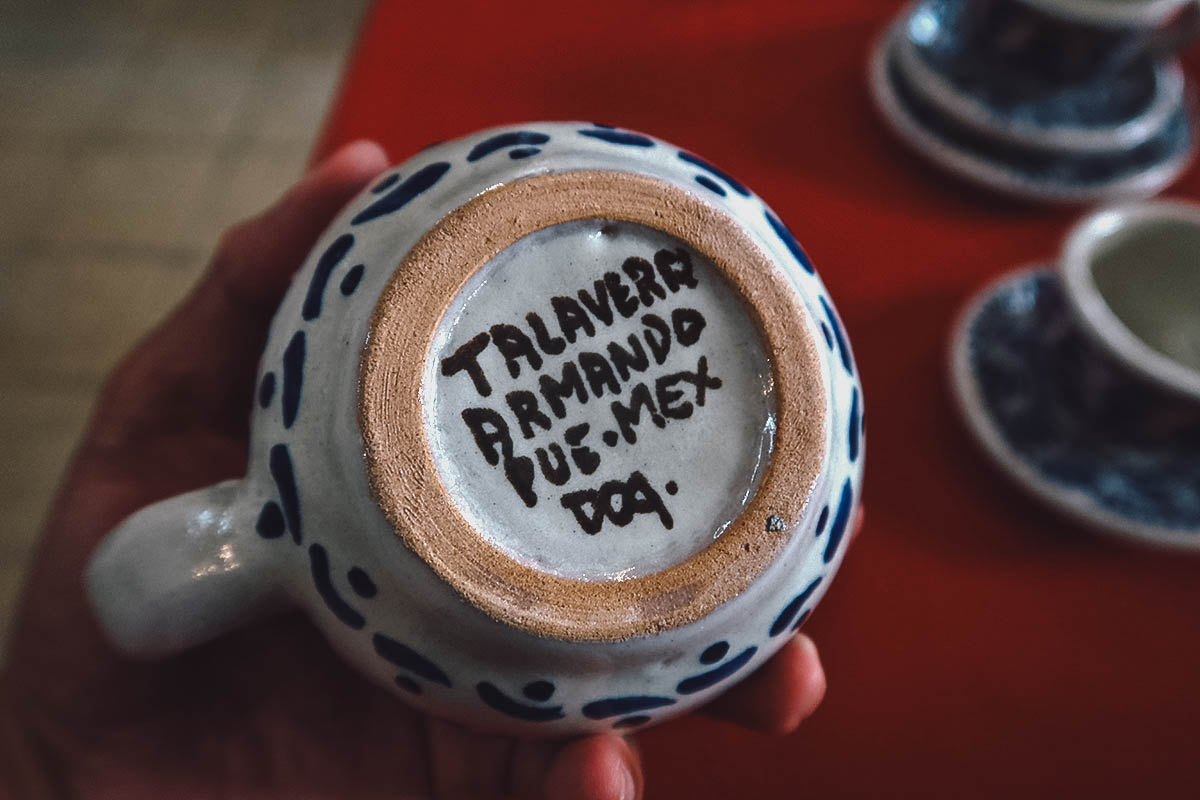
Fabrica de Talavera Armando
Address: C. 6 Nte 408, Centro histórico de Puebla, 72000 Puebla, Puebla
Operating Hours: 9AM-8PM, daily
Website: talaverarmando.com.mx
2. Talavera de La Luz
I used to live in the Azcarate neighborhood and often passed by Talavera de La Luz without realizing what was inside. Unlike the other three workshops on this list, it isn’t a “walk-in freely” type of showroom. You have to ring the buzzer at the side of the gate to be let in.
I was a bit hesitant to ring the buzzer at first but there’s no reason to be intimidated. The people who run Talavera de La Luz are welcoming and will gladly let you go through their showroom, even if you’re just there to peruse the pieces.
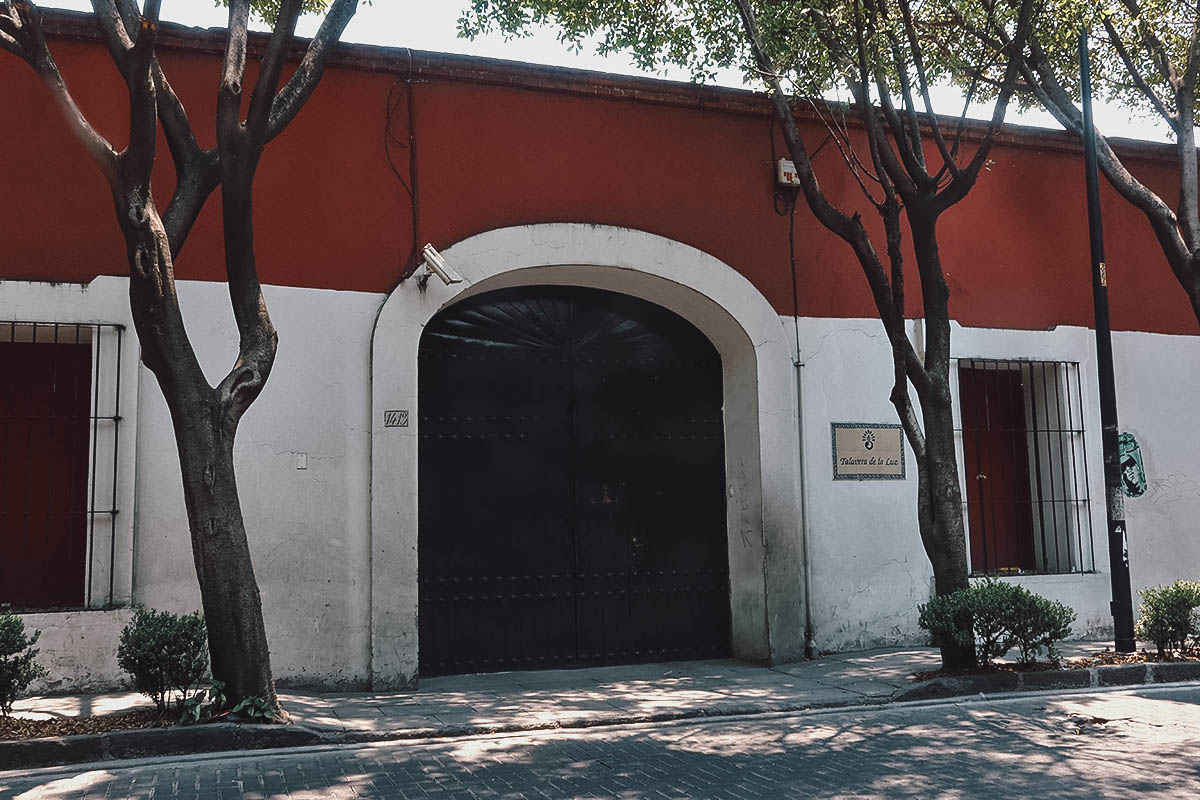
Located in Barrio de Analco, Talavera de La Luz is about a 15-minute walk east of the zocalo. It’s a bit of a trek from the Historic Center but worth it in my opinion. The pieces they have here are beautiful.
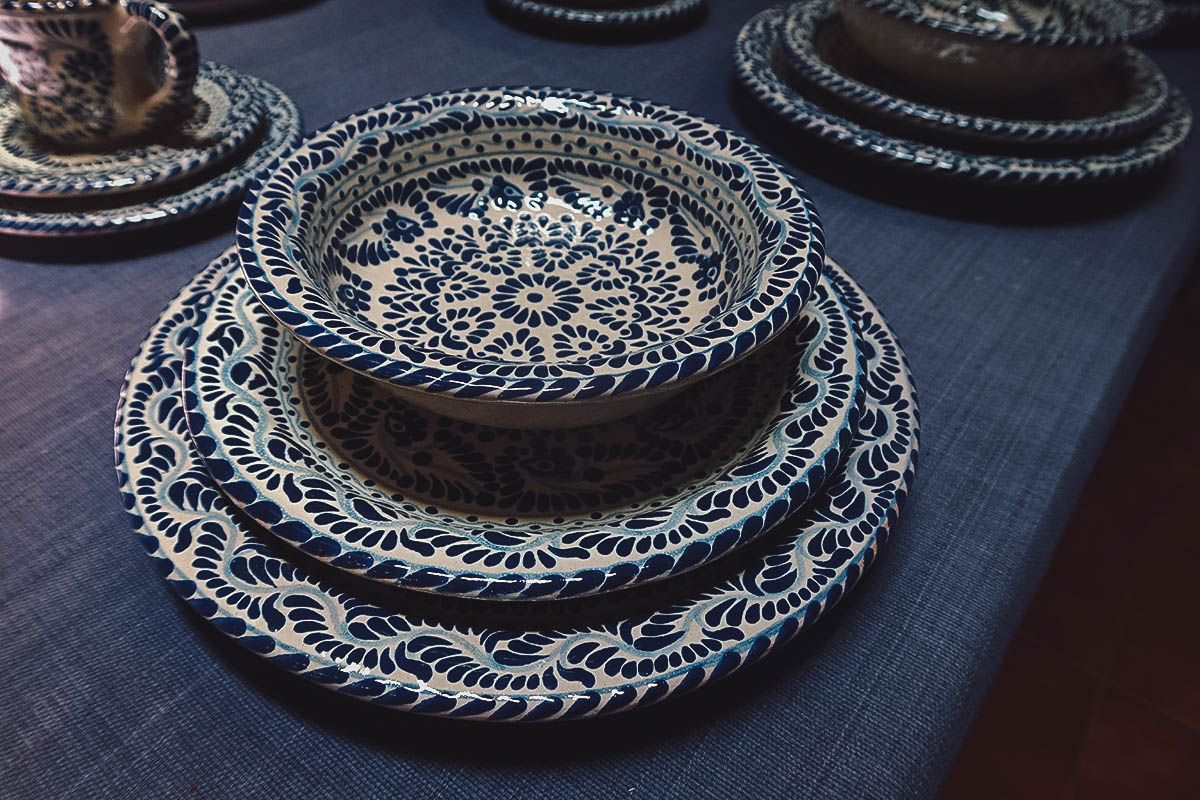
Talavera de La Luz was founded in 1996. Of the four certified workshops I’ve visited thus far, this one may be my favorite. We’re planning to buy Talavera as gifts for friends and family and we’ll probably get most of them here.
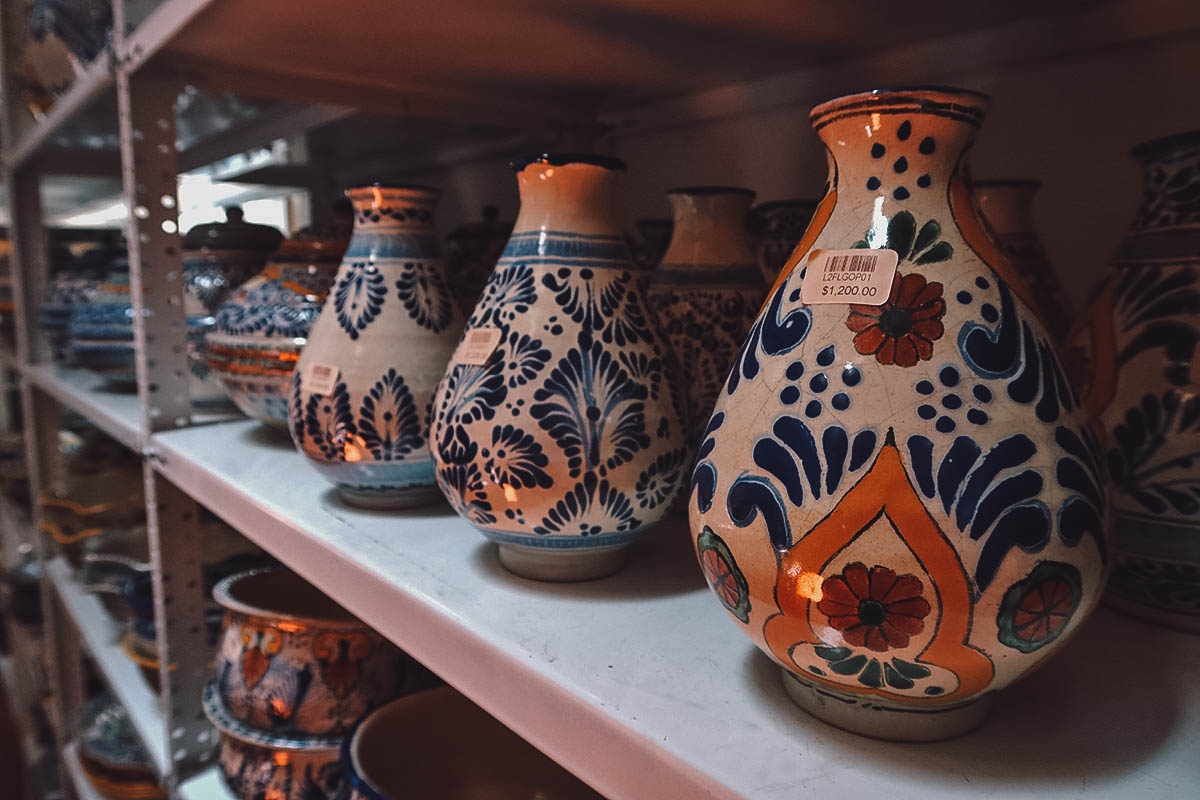
Markings indicating the workshop’s name and logo, city of production, and artist’s initials. Each piece comes with a certificate of authenticity and a hologram.
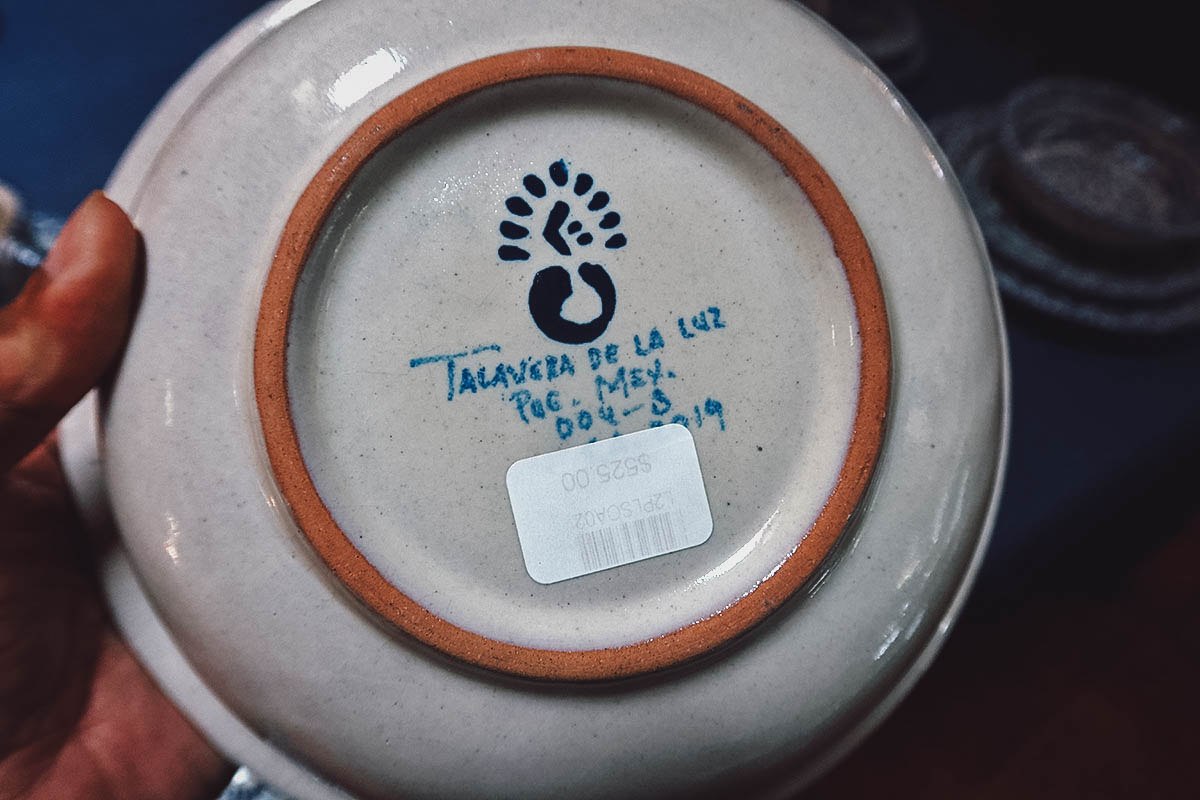
Talavera de La Luz
Address: Av. Don Juan de Palafox y. Mendoza 1413, Barrio de Analco, 72500 Puebla, Puebla
Operating Hours: 8AM-5PM, Mon-Fri / 8AM-4PM, Sat / 10AM-2PM, Sun
Website: talaveradelaluz.com
1. Uriarte Talavera
Uriarte Talavera sets the bar for the Talavera-making tradition in Mexico. Founded in 1824, it’s the oldest and most respected Talavera workshop in Puebla. Walk into their showroom and it feels like you’re stepping into an art gallery, not just a shop.
If you had time to visit just one Talavera workshop in Puebla, then it should probably be this one. Note the azulejos adorning the building’s facade.
Uriarte Talavera is located about a 15-minute walk northwest of the zocalo. They have a showroom in swanky Polanco in Mexico City as well.

Many of the designs at Uriarte are quite intricate and beautiful. They really do set the standard for Talavera in Puebla.

Unlike the other workshops I visited, Uriarte also produces more contemporary-looking pieces. If you want Talavera that’s less traditional in design, like these beautiful plates, then Uriarte is the best place for you to visit.
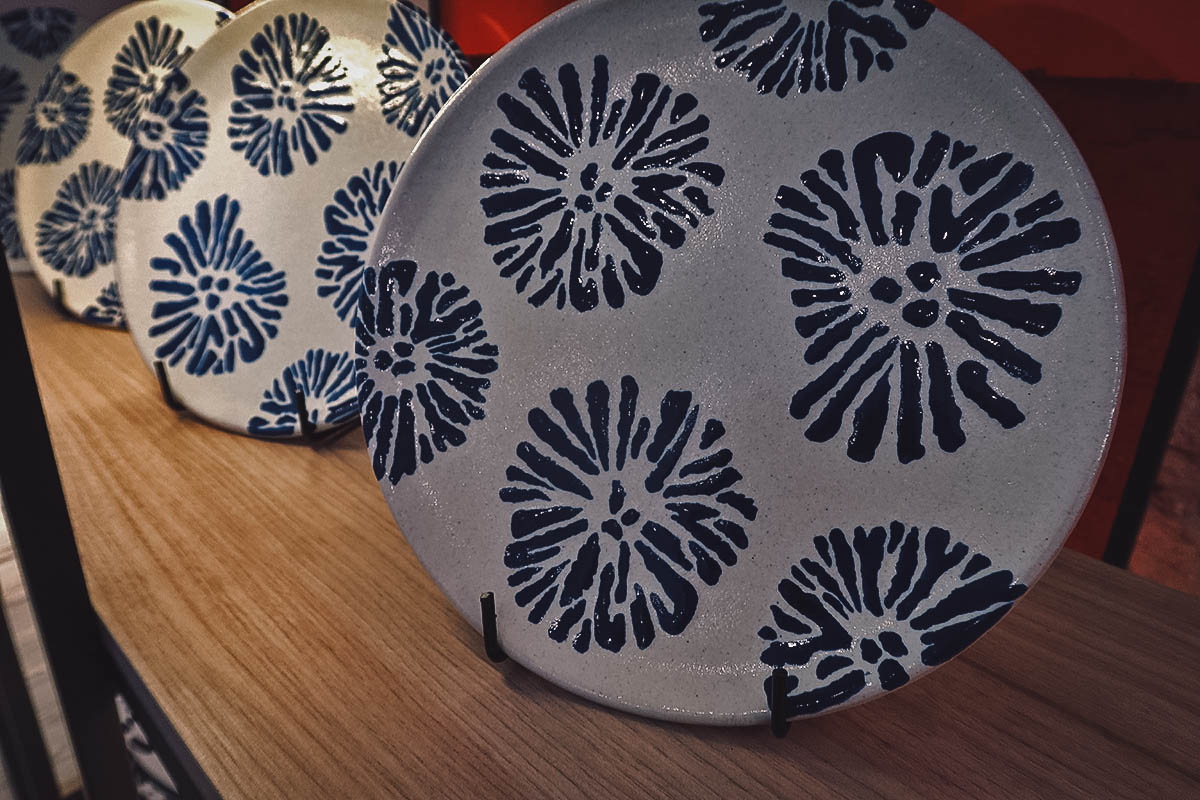
As you can see, this bowl sells for MXN 729. At today’s exchange rate, that’s a little over USD 35. The prices here do seem a little higher than at other workshops but the quality and workmanship are second to none.

Uriarte Talavera
Address: Av. 4 Pte. 911, Centro histórico de Puebla, 72000 Puebla, Puebla
Operating Hours: 10AM-7PM, Mon-Fri / 10AM-6PM, Sat-Sun
Website: uriartetalavera.com.mx
FINAL THOUGHTS ON TALAVERA IN PUEBLA
There are many compelling reasons to visit Puebla. Poblano food is one of the biggest reasons why we decided to stay here but the city’s beautiful churches and stunning colonial architecture are major draws too.
A UNESCO World Heritage Site, the Historic Center of Puebla is home to some of the most visually striking architecture in Mexico, and Talavera has a lot to do with that.
As described, we’re planning on buying several pieces of Talavera to bring home as gifts to friends and family. There are many interesting keepsakes you can buy in Puebla, but Talavera is something truly special.
It feels like you’re bringing home a piece of this World Heritage Site with you.
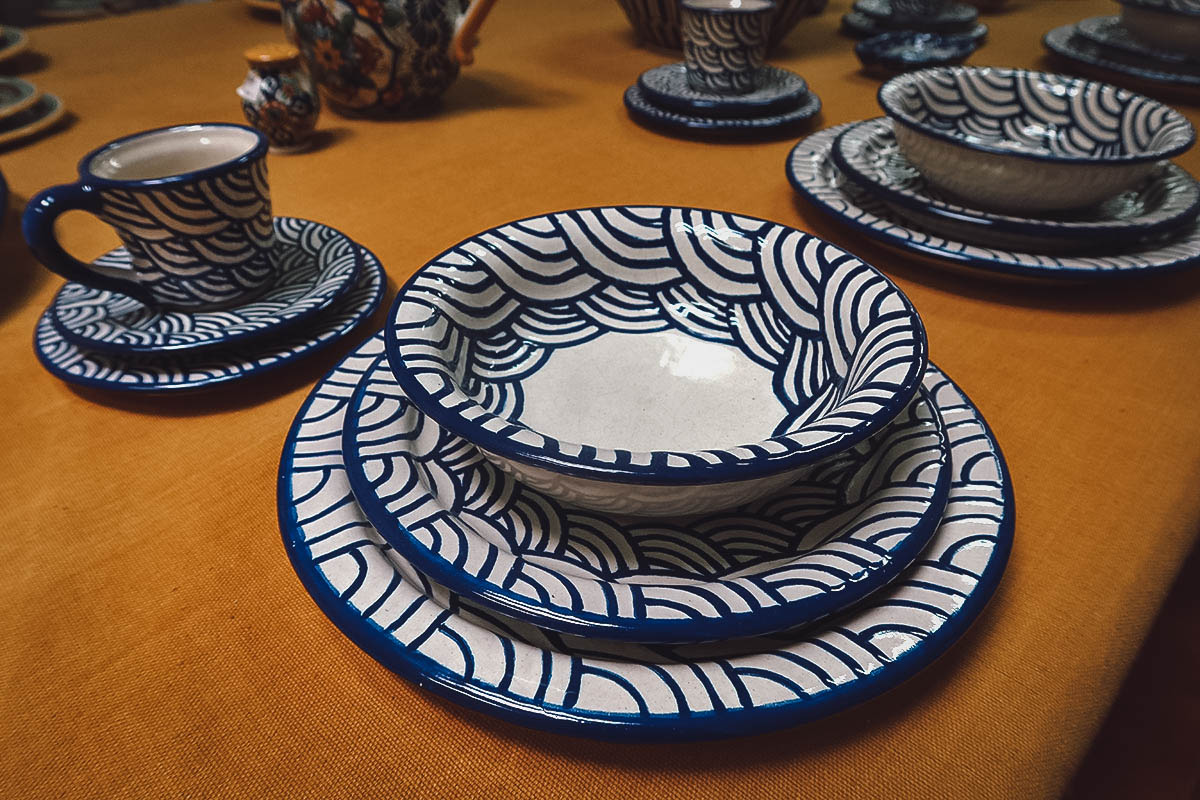
Disclosure
Some of the links in this guide to Talavera pottery in Puebla are affiliate links, meaning we’ll earn a small commission if you make a purchase at no additional cost to you. Authenticity is important to us so we only recommend products and services that we use ourselves. We really appreciate your support as it helps us keep this free Puebla travel website going. Thank you!

